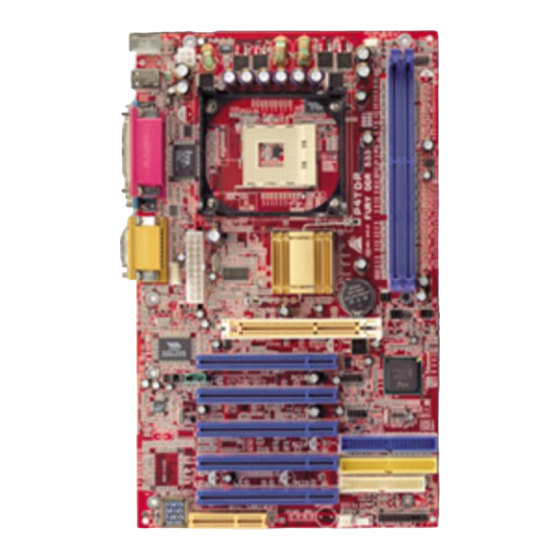
Inhaltsverzeichnis
Werbung
Verfügbare Sprachen
Verfügbare Sprachen
Quicklinks
P
4
P 4
4 T
P
FCC Statement and Copyright
This equipment has been tested and found to comply with the limits of a
Class B digital device, pursuant to Part 15 of the FCC Rules. These limits
are designed to provide reasonable protection against harmful interference
in a residential installation. This equipment generates, uses and can
radiate radio frequency energy and, if not installed and used in
accordance with the instructions, may cause harmful interference to radio
communications. There is no guarantee that interference will not occur in a
particular installation.
The vendor makes no representations or warranties with respect to the
contents here of and specially disclaims any implied warranties of
merchantability or fitness for any purpose. Further the vendor reserves the
right to revise this publication and to make changes to the contents here of
without obligation to notify any party beforehand.
Duplication of this publication, in part or in whole is not allowed without
first obtaining the vendor's approval in writing.
The content of this user's is subject to be changed without notice and we
will not be responsible for any mistakes found in this user's manual. All the
brand and product names are trademarks of their respective companies.
T
D
P
P
r
o
T D
D P
P P
P r
r o
o
i
Werbung
Inhaltsverzeichnis
Fehlerbehebung

Inhaltszusammenfassung für Biostar P4TDP Pro
-
Seite 23: Deutsch
Deutsch Merkmale des P4TDP Pro Benutzt Intel 845E/ ICH2 Chipsatz, ITE I/O- IT8712. Onboard I/O Geräte umfassen: zwei serielle Schnittstelle, eine parallele Schnittstelle, , eine PS/2-Mausschnittstelle, eine PS/2-Tastaturschnittstelle, Audio-Schnittstellen, USB-Schnittstellen, und ein Gameport. ® Unterstützung für den Prozessor Intel Pentium 4 (Socket 478) bis zu 2.4GHz. -
Seite 24: Verpackungsinhalt
Mic-in Phone-Buchse ist geteilt mit “Bass & Center”. Verpackungsinhalt HDD-Kable X 1, FDD-Kable X 1, Treiber-CD für Installation X 1 USB-Kable X 2 (optional) Layout des P4TDP Pro JKBMS1 JCFAN1 JKBV1 & Mouse JATXPWR2 JUSB1 JUSBV1 JCOM1 JPRNT1 JCOM2 JGAME1... -
Seite 25: Installation Der Cpu
Installation der CPU Ziehen Sie den Hebel seitwärts von der Sockel und neigen Sie ihn um 90-Grad nach oben. Suchen Sie Pin A im Sockel und den weißen Punkt oder die Abschnittkante in der CPU. Passen Sie Pin A mit dem weißen Punkt/der Abschnittkante zusammen und legen Sie danach die CPU ein. -
Seite 26: Ddr-Dimm-Modules: Ddr1-2
DDR-DIMM-Modules: DDR1-2 DRAM Zugriffszeit: 2.5V unbuffered DDR 200/266/Fuzzy333 MHz Type erfordert . (x16 hat keine Unterstützung) DRAM Typen: 64MB/ 128MB/ 256MB/ 512MB/ 1GB DIMM-Module (184 pin) DIMM-Sockel DDR-Module Speichergröße (MB) Standort DDR 1 64MB/128MB/256MB/512MB/1GB maximal ist DDR 2 64MB/128MB/256MB/512MB/1GB * Die obere Liste für DRAM-Konfiguration ist nur als Referenz gezeigt. Installation von DIMM-Modulen gibt eine... -
Seite 27: Jumpers, Headers, Anschlüsse & Slots
Jumpers, Headers, Anschlüsse & Slots Festplattenanschlüsse: IDE1/ IDE2 Das Mainboard hat einen 32-Bit Enhanced PCI IDE-Controller, der die Modi PIO0~4, Bus Master sowie die Ultra DMA/33/66/100 Funktion zur Verfügung stellt. Dieser ist mit zwei HDD-Anschlüssen versehen IDE1 (primär) und IDE2 (sekundär). Die IDE-Anschlüsse können eine Master- und eine Slave-Festplatte verbinden, so dass bis zu 4 Festplatten angeschlossen werden können. - Seite 28 Stromversorgungsanschlüsse: JATXPWR1/ JATXPWR2 JATXPWR2 (ATX 12V stromanschl.) JATXPWR1 (ATX Netzstromanschl.) Anschluss für Auswahl von DIMM Stromversorgung: JDIMMVOLT1(optional) Jumper offen ==> 2.5V Pin 1-2 geschlossen ==> 2.6V Pin 3-4 geschlossen ==> 2.7V JDIMMVOLT Pin 5-6 geschlossen ==> 2.8V (Default ==> 2.5V) Pin 7-8 geschlossen ==>...
- Seite 29 Front USB Header: JUSB2/ JUSB3(optional) / JUSB4(optional) Pin1,2 ==> +5V Pin3,4 ==> Data(-) Pin5,6 ==> Data(+) Pin7,8 ==> GND Pin9 ==> KEY JUSB2/3/4 Pin10 ==> NA JUSB1 (auf JUSB2 JUSB3 JUSB4 Ruckwand) Kein USB 2.0-Chip 1.1-Chip 1.1-Chip Zunahme von USB 2.0-Chip 1.1-Chip 1.1-Chip...
-
Seite 30: 5Vsb Auswahl Für Usb-Wake-Up: J1(Optional)
5V/ 5VSB Auswahl für USB-Wake-UP: J1(optional) Pin 1-2 geshlossen ==> aktiviert Pin 2-3 geschlossen ==> deaktiviert Nachdem man ein USB2.0-Chip benutzt und J1 auch in “aktiviert” Mode festgelegt wird, werden JUSB1/4(weiß) zu 5V_SB geändert. Audio Subsystem: JAUDIO1/ JCDIN1 JAUDIO1 JCDIN1 (Front Audio Header) (CD-ROM Audio-In Header) JF_AUDIO... - Seite 31 Jumper-Block Audio-Anschl sse f r die Vorderseite/ Jumper-Einstellen Konfiguration Pin 5 und 6 Audio-Ausgang-Singals werden zu der Audio- Pin 9 und 10 Ausgang-Anschluss an der R ckwand geleitet . Audio-Ausgang und Mic-In-Singals sind verf gbar Kein Jumper f r Audio-Anschl sse an der Vorderseite. installieren Anschlüsse auf der Vorderseite: JPANEL1 PWR_LED...
-
Seite 32: Jumper Zum Löschen Des Cmos: Jcmos1
Jumper zum Löschen des CMOS: JCMOS1 JCMOS1 Beschreibung Normale Operation Pin 1-2 (Default) geschlosssen CMOS-Daten Pin 2-3 loschen geschlossen Anschlüsse auf der Rückwand: JKBMS1 JPRNT1 PS/2- JGAME1 Maus Gameport PS/2- COM1 COM1 COM1 Tastatur JCOM1 JCOM2 6-Kan al-Lautsprecher Speaker-Out Speaker-Out Line-In/ Mic-In Line-In/... -
Seite 46: Problemlösung
Problemlösung MÖGLICHE URSACHE LÖSUNG Das System hat keine Spannungsversorgung. * Versichern Sie sich, dass das Stromkabel richtig Die Stromanzeige leuchtet nicht, der Lüfter im angebracht ist Inneren Stromversorgung wird nicht * Ersetzen Sie das Stromkabel eingeschaltet. Tastaturleuchten sind nicht an. * Wenden Sie sich an Ihre Kundendienststelle MÖGLICHE URSACHE LÖSUNG... - Seite 47 01/28/2003...




